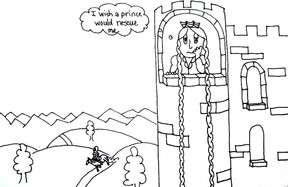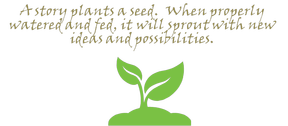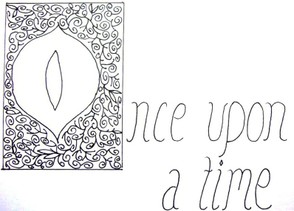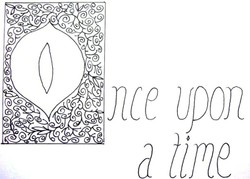 Once there was a fair maiden. She had long golden hair that hung in braids. It was so long, it stretched from high in the castle to the ground far below. She was a prisoner in that castle. Every day, she hung her hair out, hoping someone would figure out how to rescue her.
Once there was a fair maiden. She had long golden hair that hung in braids. It was so long, it stretched from high in the castle to the ground far below. She was a prisoner in that castle. Every day, she hung her hair out, hoping someone would figure out how to rescue her.
Into town galloped a knight. His armor was polished to such a high shine, he often stared at his own reflection. He stopped to get water for his horse. He looked down at his armor and noticed two long golden braids hanging from somewhere high. As he looked up, he saw a young lady with a sad face. Her hands propped her head up as she gazed across the landscape from a castle window. It was almost as if he heard her calling to him, beckoning him to save her.
Just by using a few of the five senses, I expanded this story into two paragraphs. I could actually go on and on – fleshing the story out, adding more details every time.
Furthermore, expanding upon the earlier example of the story, I am adding my own details and words to a well-known story – but all these words have my own spin, my own thoughts and ideas in the story now.






 Once there was a fair maiden. She had long golden hair that hung in braids. It was so long, it stretched from high in the castle to the ground far below. She was a prisoner in that castle. Every day, she hung her hair out, hoping someone would figure out how to rescue her.
Once there was a fair maiden. She had long golden hair that hung in braids. It was so long, it stretched from high in the castle to the ground far below. She was a prisoner in that castle. Every day, she hung her hair out, hoping someone would figure out how to rescue her.




Comments
cclitgirl: Good, because I'm fascinated by people spinning stories, and love the way you break it apart :))
Lovely article on storytelling! Loved this piece!
Mira - thank you so much!! I will post more articles soon. :) I promise. I loved doing this article and thank you so much for your feedback.
cclitgirl, this is a nice article. Look forward to your next one!
@Audrey - great to see you. I love telling a good story, hehe. Thanks for stopping by!
@ Vicki - hi there! Great to see you. :) I love storytelling and intend to get into it even more. :) I love Tracy Chapman - she's one of my favorites.
This is a great article, CC! you explain everything so well. I have never been good at storytelling, but your article inspires me just a bit. I really like Tracy Chapman's singing, too!
I loved this article! I love telling stories too! And you make it sound so interesting!
Vinaya! I LOVE telling stories. I could see myself doing just that one day. Thank you so much for stopping by and offering your insights and comments. :) Great to see you.
Katiem2 - great to see you, friend! :) Thanks for stopping by and leaving such a lovely comment. I've enjoyed reading your pages and look forward to many more. Congrats on a Wizzley score of 100. I am pouring lots of energy into writing on my blog, and a couple other websites, but I will be back here to post LOTS more. :)